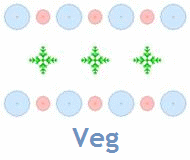What is the difference?
Grams per watt tells you the amount of dried cleaned material you can get from any lighting combination. Simply add all the watts and divide the total amount of dried material to get your G.P.W. Grams per watt is important if you have to worry about electricity costs.
Grams per square meter is the amount of dried material you can harvest from a 1m x 1m space. When breeders use this term in their descriptions it gives me a idea of what I can expect from a strain.
A issue I have constantly is plant layout in a large room.
-How is the most efficient way to set up a room to achieve maximum g.p.s.m? The question is so dynamic that it can only be answered by defining the projected plant height style etc. For example my rooms next set up, I will have stationary buckets so I will need to have 2 isles to be able to attend the plants. (I am going to try a room with rolling tables soon) my isles are 2 feet wide and I have two of them. I use netting and train the plants toward the isle to maximize space.
My isles are full of light and take up area. Lets say that I wanted to total my g.p.s.m how would I do it in a large room?
Would it be
LxW/dried mass
or LxW- area of passageways/ dried mass??? 

 is if it comes down to lights, power, energy saving and heat are ceramic metal halides the answer OR LED’s???
is if it comes down to lights, power, energy saving and heat are ceramic metal halides the answer OR LED’s??? 
 It is a joke
It is a joke




 … I’ve seen some amazing numbers being grown with LEDs in the last year… blows away most anything or anyone I’ve seen using HPS on product per watt bases… so good that the LEDs are producing more product than HPS on a per square meter bases as well… we are getting a superior product as well.
… I’ve seen some amazing numbers being grown with LEDs in the last year… blows away most anything or anyone I’ve seen using HPS on product per watt bases… so good that the LEDs are producing more product than HPS on a per square meter bases as well… we are getting a superior product as well.